The Drill Down, Issue #30: Hazardous Location Electrical Markings - Ingress Protection
 Introduction
Introduction
As we bring the Hazardous Location (HazLoc) electrical equipment markings series to a close, this edition will explore degrees of protection, as discussed in the International Electrotechnical Commission (IEC) 60079-series.
NFPA 70, Articles 500 and 505
The Division and Zone classification systems in Articles 500 and 505, respectively, do not have equipment or marking requirements for ingress protection. There may be separate electrical system requirements that closely correspond to ingress protection (a NEMA 4X enclosure as one example), but do not fall into the same category as ingress protection under IEC.
IEC 60079-Series
The “degree of protection of enclosure” or “IP”, as defined by IEC 60079-0 (2017), Clause 3.22, is a numerical classification according to IEC 60529 (IP Code) or IEC 60034-5 applied to the enclosure of electrical equipment to provide:
“Protection of persons against contact with, or approach to, live parts and against contact with moving parts (other than smooth rotating shafts and the like) inside the enclosure”,
“Protection of the electrical equipment against ingress of solid foreign objects”, and
“Where indicated by the classification, protection of the electrical equipment harmful ingress of water”.
IP is commonly referred to as “ingress protection” but typically described as “degree of protection” or “IP rating” in IEC publications.
IP ratings are mentioned in various parts of the IEC 60079-series, but it is not a required marking for equipment intended for explosive gas atmospheres. As shown on figure 1, the IP rating will often be included on the equipment label, but will be marked separately from the Ex marking (see Note 4 to IEC 60079-0 (2017), Clause 29.3.g).
As an example, for the increased safety “e” protection technique, IEC 60079-7 (2014) requires enclosures containing bare conductive live parts to be at least IP54 (Clause 4.10.1.a). Another example from IEC 60079-0 (2017), Annex A requires cable glands to be tested to a minimum of IP54 for Group II (Clause A.3.4).
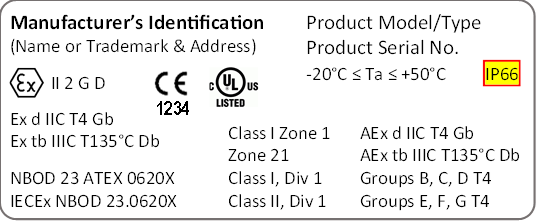 |
| Figure 1: Example label with ingress protection (IP) indicated |
The marking for the IP rating will begin with “IP”, followed by two characteristic numerals. Two optional letters may follow the numerals to provide additional information. Where a characteristic numeral is not required to be specified, it will be replaced by the letter “X”.
First characteristic numeral (table 1) – indicates that the enclosure provides protection of persons against access to hazardous parts by preventing or limiting entry of a human body part or an object held by a person and simultaneously provides protection of equipment against the ingress of solid foreign objects (IEC 60529 (2001), Clause 5).
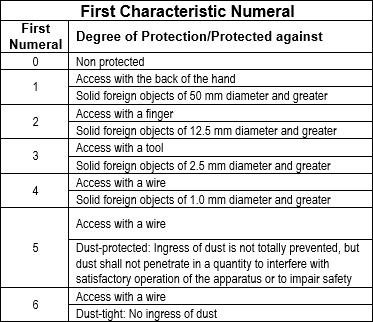 |
| Table 1: Example label with ingress protection (IP) indicated |
Second characteristic numeral (table 2) – indicates the degree of protection provide by the enclosure with respect to the harmful effects on the equipment due to the ingress of water. This designation and the associated testing are based on fresh water. (IEC 60529 (2001), Clause 6).
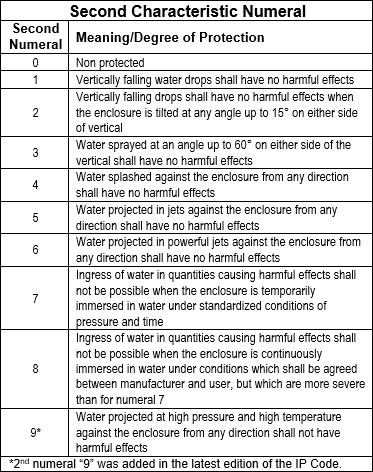 |
| Table 2: Example label with ingress protection (IP) indicated |
Additional letter (table 3) – indicates the degree of protection of persons against access to hazardous parts. Additional letters are only used if the actual protection is higher than that indicated by the first characteristic numeral or if only protection against access to hazardous parts is indicated, in which the first characteristic numeral is replaced by an “X”. (IEC 60529 (2001), Clause 7).
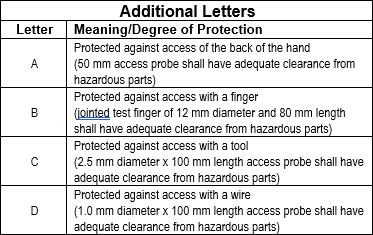 |
| Table 3: Example label with ingress protection (IP) indicated |
Supplementary letter (table 4) – indicates supplementary information and follows the second characteristic numeral or the additional letter (IEC 60529 (2001), Clause 8).
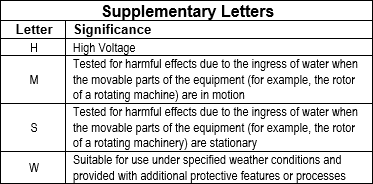 |
| Table 4: Example label with ingress protection (IP) indicated |
The example label in figure 1 shows “IP66” and would mean that the enclosure is “dust tight” (first “6”) and is also protected against “powerful water jets” (second “6”). Examples of IP markings without a characteristic numeral would be IPX6, IP6X and IPXXC.
An example given in IEC 60529 (IP Code; 2001) and using all elements is “IP23CS” and is interpreted as follows:
IP Code letters.
2 First characteristic numeral denoting that the enclosure protects persons against access to hazardous parts with fingers and protects the equipment inside the enclosure against the ingress of solid foreign objects with a diameter of 12.5 mm or greater.
3 Second characteristic numeral denoting that the enclosure protects the equipment inside against the harmful effects of water sprayed against the enclosure.
C Additional letter denoting that the enclosure protects persons handling tools having a diameter of 2.5 mm or greater and a length not exceeding 100 mm against access to hazardous parts (the tool may penetrate the enclosure up to its full length).
S Supplementary letter signifying that the enclosure is tested for protection against harmful effects due to the ingress of water when all the parts of the machinery are stationary.
Conclusion
While IP ratings are not a required component of the IEC hazardous area markings, various Ex components may have specific IP requirements that can be verified by understanding the IP rating and associated marking.
This concludes the Drill Down series on HazLoc electrical equipment markings.
As a reminder, this series in not an attempt to instill competence to an individual, but has the intended purpose of bringing awareness of the applicable standards incorporated through U.S. Coast Guard regulations and to what is indicated by each marking component of HazLoc electrical equipment.
Published 02Oct2023.